 |
 |
|
Kenji Misumi special
By Tom Mes
Kenji Misumi seemingly needs little introduction. Best known for his work on the Baby Cart and Zatoichi series, his image has been long been well established as one of Japan's great artisans, a samurai cinema stylist with a penchant for creative bloodletting. The words of French critic Max Tessier sum up this consensus, referring to his work as "craftsmanship at its highest level".
Well, it's time for a drastic re-appraisal. The attention given to Misumi's formal talents has left one of his main qualities undiscovered: his humanism. As an incentive to further study of this truly great director, here follows a look at some of the various facets of his career.
Satan's Sword
Buddha
Destiny's Son
Ken
Sword Devil
Zatoichi and the Chess Expert
Wrath of Daimajin
Baby Cart in the Land of Demons
The Last Samurai
|
 |
Satan's Sword
Original Title: Daibosatsu Toge
Director: Kenji MISUMI
Cast: Raizo ICHIKAWA, Kojiro HONGO, Tamao NAKAMURA, Chishu RYU
Running time: 105 mins.
Year: 1960
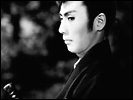 The saga of Daibosatsu Toge, or Great Buddha Pass, is one of those mainstays of the chanbara genre. That Kihachi Okamoto's Sword of Doom is perhaps its most internationally feted example is ironic, because it is incomplete. Its famously abrupt ending, with the psychotic samurai Ryunosuke Tsukue (Tatsuya Nakadai) forever frozen in his paranoid rage, has given rise to many an interpretation, but the simple reason is that the film never got the follow-ups it required. Daibosatsu Toge is normally told as a triptych, as is the case with the versions directed by Tomu Uchida (1957-59, with Chiezo Kataoka as Tsukue) and Kenji Misumi. The saga of Daibosatsu Toge, or Great Buddha Pass, is one of those mainstays of the chanbara genre. That Kihachi Okamoto's Sword of Doom is perhaps its most internationally feted example is ironic, because it is incomplete. Its famously abrupt ending, with the psychotic samurai Ryunosuke Tsukue (Tatsuya Nakadai) forever frozen in his paranoid rage, has given rise to many an interpretation, but the simple reason is that the film never got the follow-ups it required. Daibosatsu Toge is normally told as a triptych, as is the case with the versions directed by Tomu Uchida (1957-59, with Chiezo Kataoka as Tsukue) and Kenji Misumi.
Made from a screenplay by Misumi's mentor Teinosuke Kinugasa, the story concerns Tsukue, a samurai rotten to the core who delights in violence. Despised by his ailing father (here played by Ozu stalwart Chishu Ryu), he kills without reason. When he slays a challenger in a duel, he does so after raping the man's wife, who came to him to plead for her husband's life. When the woman becomes pregnant he takes her in, but treats her like dirt. Meanwhile the younger brother of his victim swears revenge and sets out to confront Tsukue.
Satan's Sword shows a good part of Misumi's singular visual traits already firmly in place: battles take place among barren trees, conspicuously artificial but all the more beautiful for it; shadows loom heavy in the key scene in which Tsukue believes he is haunted by demons and goes on a paranoid rampage against the clan that hired him. To achieve this, Misumi worked with regular set designer Akira Naito, who had an enormous impact on the development of the director's visual sense. Theirs was a partnership not unlike that of Seijun Suzuki and Takeo Kimura at Nikkatsu, both teams preferring the stylised and the artificial to the realistic.
Misumi spent almost his entire career at Daiei. Entering the studio in the early 1950s after his return from a Russian POW camp, he directed chanbara films, his favourite genre since childhood, right until the studio's demise in 1971. Working at an average of three or four films a year, he directed close to sixty of them for the studio, a huge number of these starring Raizo Ichikawa. Ichikawa was the undisputed star of the Daiei stable after his turn in Kenji Mizoguchi's Tales of the Taira Clan (Shin Heike Monogatari, 1955) and until his untimely death of cancer in 1969 at the age of 38. Satan's Sword marks the sixth collaboration between the two men, but remains less well known than the Sleepy Eyes of Death series, of which Misumi directed three episodes and to which this forms a predecessor of sorts, with Kyoshiro Nemuri exhibiting many of Ryunosuke Tsukue's dark tendencies. Ichikawa's sullen performance of Tsukue is remarkably similar to his later turn as Nemuri.
Satan's Sword II (Daibosatsu Toge: Ryujin no Maki) followed the same year, detailing the gradual demise of Tsukue and his questioning of his own morals. Part three came a year later, directed by Issei Mori.
|
 |
Buddha
Original Title: Shaka
Director: Kenji MISUMI
Cast: Kojiro HONGO, Shintaro KATSU, Hiroshi KAWAGUCHI, Raizo ICHIKAWA, Machiko KYO, Isuzu YAMADA, Fujiko YAMAMOTO
Running time: 156 mins.
Year: 1961
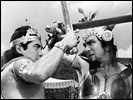 Inspired by Ben-Hur and The Ten Commandments, Daiei president Masaichi Nagata chose no less than the life of Buddha as the subject of Japan's first 70mm religious epic. Effectively gambling the studio's future on the project, he gave helming duties to Misumi, who was then emboldened by the success of his modest period pieces, which on several occasions had outgrossed Daiei's A-list productions. Inspired by Ben-Hur and The Ten Commandments, Daiei president Masaichi Nagata chose no less than the life of Buddha as the subject of Japan's first 70mm religious epic. Effectively gambling the studio's future on the project, he gave helming duties to Misumi, who was then emboldened by the success of his modest period pieces, which on several occasions had outgrossed Daiei's A-list productions.
The film moves through the deity's life from his renunciation of his father's fortunes and his lengthy meditation under the Bodhi tree, via the transformation of prince Siddharta into Buddha, to the miracles he performs for the poor and needy as his teachings spread across the land. The results are much as one would expect: big sets, thousands of extras, and an all-star cast of Daiei's top stars. Though inevitably less lavish and resplendent than the films that inspired it, this is certainly not for lack of trying, as the climactic destruction of an entire city shows. That all the Indian characters in the film are played by Japanese actors might raise an eyebrow, but Shintaro Katsu as Devadatta is certainly no more outlandish an image than Yul Brynner as an Egyptian pharaoh. (The only non-Japanese in the cast is Filipino actress Charito Solis, employed here mainly, it seems, for the size of her bosom.)
Buddha is occasionally clumsy and has histrionic performances to spare, but while it will never go down into Japanese film history as anything more than an amusing footnote, it does hold great value in the development of Misumi's signature style. The choice to show the Buddha only as a shadow or in silhouette after his emergence from under the Bodhi tree gives the director ample opportunity to experiment with the kind of expressionist compositions that would become such a characteristic in his later work, all the way down to the Baby Cart films.
Nagata's gamble, incidentally, paid off. The success of Buddha paved the way for Misumi to join the ranks of Daiei's top directors, men like Kon Ichikawa and Kenji Mizoguchi. The director declined the prestige, however, and preferred to keep working on his beloved chanbara.
|
 |
Destiny's Son
Original Title: Kiru
Director: Kenji MISUMI
Cast: Raizo ICHIKAWA, Shiho FUJIMURA, Masayo BANRI, Mayumi NAGISA, Junichiro NARITA
Running time: 73 mins.
Year: 1962
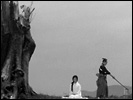 The same year Misumi directed the first Zatoichi film, he also made this forgotten masterpiece, a rapturously beautiful evocation of the plight of fatherless men (he himself was abandoned by his parents as a child) and the futility of bushido, scripted by Kaneto Shindo from a Renzaburo Shibata novel. The same year Misumi directed the first Zatoichi film, he also made this forgotten masterpiece, a rapturously beautiful evocation of the plight of fatherless men (he himself was abandoned by his parents as a child) and the futility of bushido, scripted by Kaneto Shindo from a Renzaburo Shibata novel.
Shingo (Ichikawa) is the product of a scandalous affair between a guardsman and the woman he was assigned to execute. Unaware of his origins, Shingo grows up as the adopted son of a samurai family, but learns the truth upon his father's deathbed. Fatherless and masterless, he goes out into the world and finds employment with the clan lord Matsudaira to whom he devotes himself wholeheartedly. But even Shingo's superior swordsmanship can't avert Matsudaira's downfall at the hands of his enemies.
Destiny's Son is a film filled with stylistic highlights: the one-take dolly shot of Ichikawa's running battle with a battalion of swordsmen under an inky sky, the labyrinth of empty castle chambers through which he attempts to find his ambushed master, the scene in which the unarmed hero defends himself with a twig of cherry blossom, and especially the recurring flashback to his mother's execution at the hands of her own lover, in a barren landscape beside a single, ancient tree.
Perhaps most impressive of all, though, is the genuine doubt that speaks from the film as to the value of the warrior code and, by implication, of the samurai lifestyle as a whole.
If the protagonist of Satan's Sword was merely a samurai who abused his position to give vent to his psychotic tendencies, in Destiny's Son the hero is the bushido ideal of the valorous and disciplined retainer, who, despite all his prowess with the sword and his noble heart, is powerless to prevent the deaths of those around him.
|
 |
Ken
Original Title: Ken
Director: Kenji MISUMI
Cast: Raizo ICHIKAWA, Yusuke KAWAZU, Yukiko FUJI, Akitake KONO
Running time: 98 mins.
Year: 1964
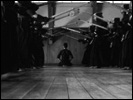 Among his 60-odd productions, Ken is Misumi's only film in contemporary setting. Although it falls outside the genre programmers he habitually worked in, it tellingly treats exactly the same theme as his period pieces: the conflict between bushido and humanism. Among his 60-odd productions, Ken is Misumi's only film in contemporary setting. Although it falls outside the genre programmers he habitually worked in, it tellingly treats exactly the same theme as his period pieces: the conflict between bushido and humanism.
Based on the novella by Yukio Mishima (who allegedly was a great fan of Destiny's Son), Ken is the story of Jiro Kokubu (Ichikawa), star pupil of the university kendo club, for whom the sport is a way of life. Unwavering in his asceticism, he willingly foregoes girls, parties and rock music, devoting his entire being to the practice of kendo. The other students, in particular a fellow senior named Kagawa (Kawazu, star of Nagisa Oshima's early films), ridicule him behind his back, but are unable to better him in the dojo. On a training trip before a major tournament, where the group is subjected to Kokubu's gruelling regimen, Kagawa rebels, dragging the younger students with him on a collision course with their captain.
For Mishima, Jiro Kokubu was the embodiment of his ideals, a modern-day Japanese living by the warrior code, renouncing the temptations of hedonism and consumer society. He is the personification of the values the author detailed in his book-length essay Hagakure Nyumon, a study of the Hagakure, the book of the samurai, which the controversial writer considered his guide to life. Misumi takes a more distant look at the same story. Through the eyes of freshman student Mibu, torn between his admiration for his team captain and his wish to live it up before entering the adult world, the director weighs Kokubu's steadfast stoicism instead of idealising it. He adds more balance in the shape of a potential love interest for Kokubu, but with the obvious evil of swords and killing out of the way Misumi finds it far more difficult to come to a conclusion.
Shot in suitably high-contrast black and white, Ken is closer in style and tone to the seishun eiga (at times it evokes Kon Ichikawa's Punishment Room / Shokei no Heya, 1956) and the early works of the Japanese New Wave than to any of Misumi's own chanbara films. An overlooked gem that sheds a very different light on its director.
|
 |
Sword Devil
Original Title: Kenki
Director: Kenji MISUMI
Cast: Raizo ICHIKAWA, Kei SATO, Michiko SUGATA, Goro MUTSUMI
Running time: 86 mins.
Year: 1965
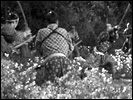 Hanpei (Ichikawa once more) is a soft-spoken gardener, a vassal without rank who is the butt of everyone's jokes. A persistent rumour goes around town that he was born from a coupling between a woman and a dog, and he is treated no better than the average canine. He meekly undergoes the repeated vandalism of his flowerbeds and the taunts of those who rank above him in the hierarchy. Hanpei (Ichikawa once more) is a soft-spoken gardener, a vassal without rank who is the butt of everyone's jokes. A persistent rumour goes around town that he was born from a coupling between a woman and a dog, and he is treated no better than the average canine. He meekly undergoes the repeated vandalism of his flowerbeds and the taunts of those who rank above him in the hierarchy.
But Hanpei's dim-witted appearance hides an enormous capacity from learning upon seeing. No sooner has he observed an again swordsman practicing his draws on a deserted hilltop, or he turns into swordfighter of frightening ability himself. Remarking his skills, one of the clan lieutenants slyly befriends the good-natured young man, winning his trust in the hopes of having Hanpei do his dirty work.
Misumi's second adaptation of a Renzaburo Shibata novel makes an intriguing companion to its predecessor, Destiny's Son. Both films deal with orphaned young men adopting father figures and being drawn into backroom intrigue despite their prowess with the sword. Sword Devil takes a more comic tone for the first part of its narrative, occasionally crossing the line into silliness, but with Ichikawa always convincing as the naïve Hanpei. Its parodic nature also makes it one of Misumi's strongest attacks on bushido values, with the downtrodden hero defeating dozens of highly trained aristocratic warriors by simply adhering to the sole lesson taught to him by the old samurai: "Just draw, kill and sheath. That's all there is to it."
|
 |
Zatoichi and the Chess Expert
Original Title: Zatoichi Jigoku Tabi
Director: Kenji MISUMI
Cast: Shintaro KATSU, Mikio NARITA, Chizuru HAYASHI, Kaneko IWASAKI, Gaku YAMAMOTO
Running time: 87 mins.
Year: 1965
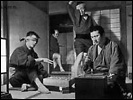 The twelfth entry in the Zatoichi series, and the director's third, marks the meeting of two giants of the chanbara film: Kenji Misumi and the towering Daisuke Ito. Starting his career in the silent era, Ito is one of the undisputed masters of the genre. A D.W. Griffith of the samurai film, he introduced a dynamic visual style of fast cuts and moving cameras and was one of the first to break away from the static visual tradition inherited from the theatre. With a career that lasted well into the 1970s, Ito was also one of the first to toy with what are often called nihilist heroes, protagonists that were quite different from the heroic and virtuous samurai stereotype. The twelfth entry in the Zatoichi series, and the director's third, marks the meeting of two giants of the chanbara film: Kenji Misumi and the towering Daisuke Ito. Starting his career in the silent era, Ito is one of the undisputed masters of the genre. A D.W. Griffith of the samurai film, he introduced a dynamic visual style of fast cuts and moving cameras and was one of the first to break away from the static visual tradition inherited from the theatre. With a career that lasted well into the 1970s, Ito was also one of the first to toy with what are often called nihilist heroes, protagonists that were quite different from the heroic and virtuous samurai stereotype.
A collaboration between two such greats creates a promise that, truth be said, the film doesn't quite fulfil. Zatoichi and the Chess Expert is a fine entry in the series, certainly, but no greater than any of Misumi's other contributions. The early section of the film replays an entire key scene from the original The Tale of Zatoichi (1962), but things pick up when a cool and menacing Mikio Narita makes his entrance as Jumonji, the chess player of the title. Initially becoming a travel partner to Zatoichi, leading to several fine chess match scenes including one where Jumonji levels the odds by playing blindfolded, his dark side reveals itself when Zatoichi meets a pair of teenagers looking for the man who murdered their father… during a chess match.
This is a solid enough entry in the series, boosted by fine camerawork from Misumi's regular cinematographer Chishi Makiura (using browns and reds as dominant colours) and several good scenes, including an opening sequence that is one of the best and most compact examples of Misumi's unique visual style.
|
 |
Wrath of Daimajin
Original Title: Daimajin Ikaru
Director: Kenji MISUMI
Cast: Shiho FUJIMURA, Kojiro HONGO, Taro MARUI, Takashi KANDA
Running time: x mins
Year: 1966
 It's probably his involvement with studio franchises that has kept Misumi from being seen as more than a great craftsman by critics and historians. He was always content to be working in popular cinema, of which the Zatoichi series and above all this entry in the Daimajin trilogy are perhaps the ultimate examples. It's probably his involvement with studio franchises that has kept Misumi from being seen as more than a great craftsman by critics and historians. He was always content to be working in popular cinema, of which the Zatoichi series and above all this entry in the Daimajin trilogy are perhaps the ultimate examples.
The second in the trilogy, Wrath of Daimajin revolves around the good citizens of a prosperous coastal domain overrun by jealous invaders from the neighbouring clan. Subjecting the poor folk to tyranny, the barbarians hope to bring them to their knees by blowing up the stone statue of their god Majin. As the icon scatters into the sea in a thousand pieces, all hope seems lost, but a single escapee's persistent prayers bring the stone god back to life for some well-deserved payback.
A medieval variation on the kaiju films essentially aimed at young audiences, the Daimajin films are free of most of the more substantial elements of Misumi's major films. The story takes a very fatalist viewpoint of humanity, characters are drawn in unmistakable terms of good and evil and not a drop of blood is spilled despite healthy doses of action. As such, this is hardly a standout within the director's body of work, and for once really does see Misumi operating on the level of pure craftsmanship. No better or worse than the other two entries (directed by Kimiyoshi Yasuda and Issei Mori), this is enjoyable juvenalia and certainly preferable, nostalgia notwithstanding, to any of the same period's Godzilla films.
|
 |
Baby Cart in the Land of Demons
Original Title: Kozure Okami: Meifumado
Director: Kenji MISUMI
Cast: Tomisaburo WAKAYAMA, Akihiro TOMIKAWA, Shingo YAMASHIRO, Eiji OKADA, Minoru OKI, Michiyo YASUDA
Running time: 90 mins.
Year: 1973
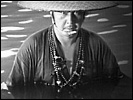 Despite its enduring popularity in the West, the Baby Cart series is still often seen as consisting of two distinct parts. Ask any fan what his favourite episode is and he will almost invariably tell you it's one of the first three. The three later entries are often given short shrift. Certainly, Baby at the River Styx looms mightily over the others, but Buichi Saito's fourth instalment Baby Cart in Peril, with its riveting story of the vengeful Oyuki, her breast tattooed with a blood red Kintaro, and Yoshiyuki Kuroda's White Heaven in Hell, the least liked but ironically the most comicbook-like of all six, have their own special charm and deserve a re-evaluation. Despite its enduring popularity in the West, the Baby Cart series is still often seen as consisting of two distinct parts. Ask any fan what his favourite episode is and he will almost invariably tell you it's one of the first three. The three later entries are often given short shrift. Certainly, Baby at the River Styx looms mightily over the others, but Buichi Saito's fourth instalment Baby Cart in Peril, with its riveting story of the vengeful Oyuki, her breast tattooed with a blood red Kintaro, and Yoshiyuki Kuroda's White Heaven in Hell, the least liked but ironically the most comicbook-like of all six, have their own special charm and deserve a re-evaluation.
So too does part five, Baby Cart in the Land of Demons, which marks the return of Kenji Misumi after a brief absence during which he made the first Hanzo the Razor film with Shintaro Katsu. Misumi's penultimate film, it's without doubt the darkest of the series, as well of Misumi's career. Its story is a relentlessly tale of backstabbing and betrayal, of double and triple crosses, as clan underlings hire Itto Ogami to dispose of their leader, who has for no apparent reason incarcerated his infant son and heir, and replaced him with a girl he has adopted. Meanwhile, Ogami loses track of his own son Daigoro, who falls in with a lady pickpocket but is arrested by the constable on her tracks and submitted to a public whipping.
Parallel with its darkness, Baby Cart in the Land of Demons is the strongest evocation of the father-son bond in Misumi's work. Ogami's job is to kill a child and its foster parents so that the real son may be freed, while a close-up of Ogami and Daigoro's tightly clasped hands after the boy's ordeal is held so long that it becomes an almost desperate outcry. Here, the director's humanism is struggling to wrench itself loose from its violent bonds, something that would finally be achieved in Misumi's next and final film, The Last Samurai.
|
 |
The Last Samurai
Original Title: Okami yo Rakujitsu o Kire
Director: Kenji MISUMI
Cast: Hideki TAKAHASHI, Ken OGATA, Keiko MATSUZAKA, Takahiro TAMURA
Running time: 158 mins.
Year: 1974
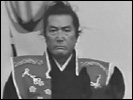 Misumi's The Last Samurai takes place in the same period and setting as its later Hollywood namesake. But this is where similarities end. Instead of Ed Zwick's naïve celebration of bushido and feudalism as something quaint, exotic and idyllic, Misumi draws a thick red line through Tokugawa and samurai society, renouncing it once and for all as an inhuman dictatorship. His final film sees him making the choice that he had been weighing and contemplating for his entire career. Misumi's The Last Samurai takes place in the same period and setting as its later Hollywood namesake. But this is where similarities end. Instead of Ed Zwick's naïve celebration of bushido and feudalism as something quaint, exotic and idyllic, Misumi draws a thick red line through Tokugawa and samurai society, renouncing it once and for all as an inhuman dictatorship. His final film sees him making the choice that he had been weighing and contemplating for his entire career.
Set during the 19th-century social upheaval that helped bring three centuries of shogunate rule to its knees, The Last Samurai follows Toranosuke (a physically and dramatically impressive Takahashi, former star of Seijun Suzuki's Fighting Elegy and Tattooed Life), a paragon of the valiant samurai who is confused by the changes happening around him. His codes tell him to defend the shogunate on the side of the Shinsengumi militia, but his teacher (Tamura of Yasuzo Masumura's Hoodlum Soldier series) has already defected to the other side and tells him it's time to lay down the sword and look toward the future. When the latter stealthily arranges for Toranosuke to meet the beautiful Reiko (Matsuzaka), the warrior's doubt begin to grow.
Made for Shochiku studios, the epic The Last Samurai sees the director operating in a more naturalist, down-to-earth style that combines well with the overall humanist tone of the film, as if the director wanted to get rid of any hint of sensationalism. Gone are the thick shadows, the splashes of primary colour and the intense close-ups. They are replaced by a palette of earthy tones and a more sedate use of the camera. The exaggerated violence so often seen as a trademark of Misumi's work surfaces here only once, in the scene in which the furious Toranosuke goes after the trio of soldiers that killed his wife, and it comes across as suitably jarring.
With The Last Samurai, Kenji Misumi does something that few artists ever have the chance to do: deliver his final and definitive statement, reaching a conclusion that brings his entire body of work to a close. A genuinely great film.
|